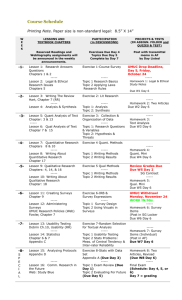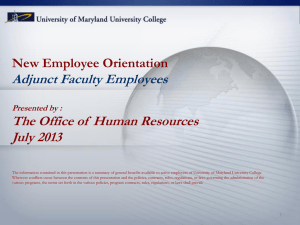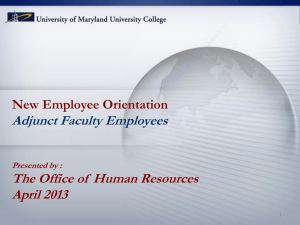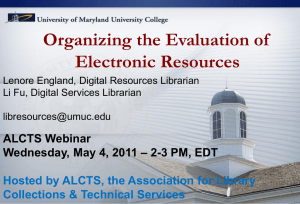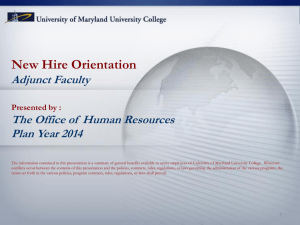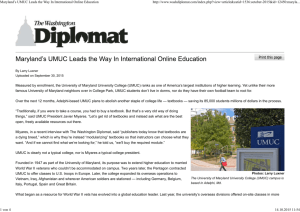University of Maryland University College
advertisement
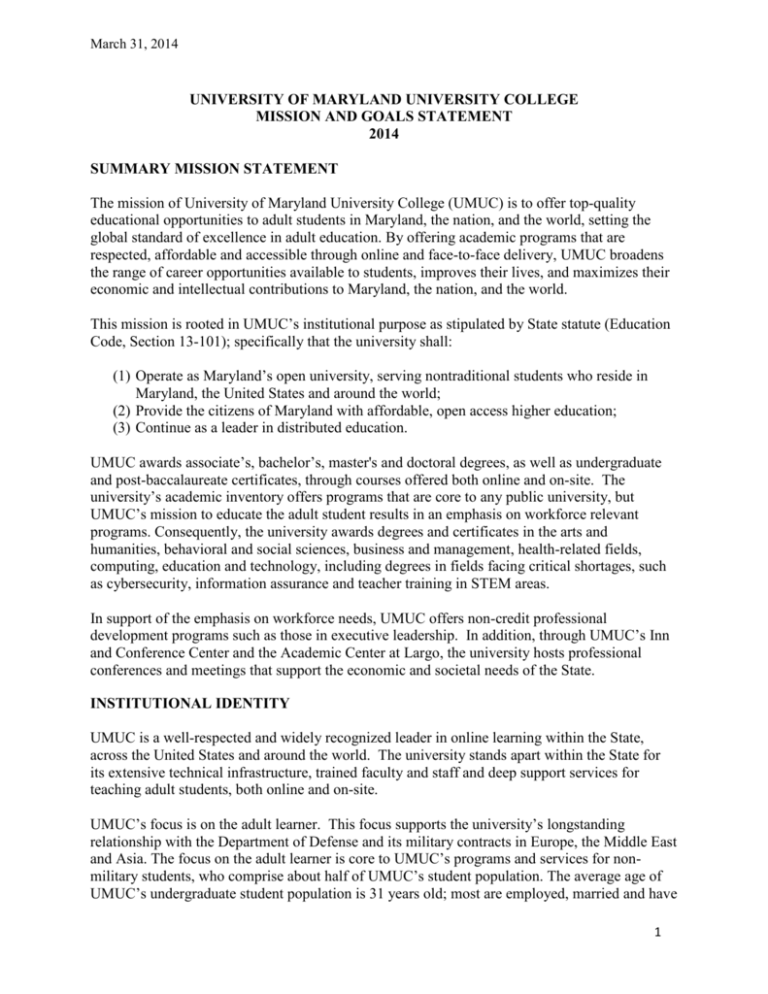
March 31, 2014 UNIVERSITY OF MARYLAND UNIVERSITY COLLEGE MISSION AND GOALS STATEMENT 2014 SUMMARY MISSION STATEMENT The mission of University of Maryland University College (UMUC) is to offer top-quality educational opportunities to adult students in Maryland, the nation, and the world, setting the global standard of excellence in adult education. By offering academic programs that are respected, affordable and accessible through online and face-to-face delivery, UMUC broadens the range of career opportunities available to students, improves their lives, and maximizes their economic and intellectual contributions to Maryland, the nation, and the world. 2 This mission is rooted in UMUC’s institutional purpose as stipulated by State statute (Education Code, Section 13-101); specifically that the university shall: (1) Operate as Maryland’s open university, serving nontraditional students who reside in Maryland, the United States and around the world; (2) Provide the citizens of Maryland with affordable, open access higher education; (3) Continue as a leader in distributed education. UMUC awards associate’s, bachelor’s, master's and doctoral degrees, as well as undergraduate and post-baccalaureate certificates, through courses offered both online and on-site. The university’s academic inventory offers programs that are core to any public university, but UMUC’s mission to educate the adult student results in an emphasis on workforce relevant programs. Consequently, the university awards degrees and certificates in the arts and humanities, behavioral and social sciences, business and management, health-related fields, computing, education and technology, including degrees in fields facing critical shortages, such as cybersecurity, information assurance and teacher training in STEM areas. In support of the emphasis on workforce needs, UMUC offers non-credit professional development programs such as those in executive leadership. In addition, through UMUC’s Inn and Conference Center and the Academic Center at Largo, the university hosts professional conferences and meetings that support the economic and societal needs of the State. INSTITUTIONAL IDENTITY UMUC is a well-respected and widely recognized leader in online learning within the State, across the United States and around the world. The university stands apart within the State for its extensive technical infrastructure, trained faculty and staff and deep support services for teaching adult students, both online and on-site. UMUC’s focus is on the adult learner. This focus supports the university’s longstanding relationship with the Department of Defense and its military contracts in Europe, the Middle East and Asia. The focus on the adult learner is core to UMUC’s programs and services for nonmilitary students, who comprise about half of UMUC’s student population. The average age of UMUC’s undergraduate student population is 31 years old; most are employed, married and have 1 March 31, 2014 children. As a group, these students have attended an average of five other colleges or universities before transferring to UMUC and the university aims its student and academic support services to the needs of these adult learners. Given UMUC’s mission and student population, it is a natural partner with community colleges within the State and across the nation. Consequently, UMUC has articulation agreements with all 16 community colleges within the State and with 53 other community colleges outside of Maryland, representing 24 states. These relationships are an integral part of the university’s identity and account for the fact that UMUC takes more transfer students than any other college or university in the State. As an open university committed to providing access to all students who wish to pursue higher education, UMUC does not employ selective admissions to undergraduate programs, but instead admits all applicants who have earned a high school diploma or the equivalent. Likewise, most UMUC graduate programs require only a baccalaureate degree for admission. UMUC has a richly diverse student body, faculty and staff. In fall 2013, 38% of UMUC’s stateside undergraduate students and 45% of its graduate students were African-American or Hispanic. Consequently, the university awards a large number of degrees to these groups each year. In FY 2013, 33% of UMUC bachelor’s degrees, 43% of its master’s degrees, and 47% of its doctoral degrees were awarded to African-American or Hispanic students, totaling more than 3,000 degrees. Thirty-three percent of UMUC’s full-time faculty and staff are African American or Hispanic. UMUC’s Carnegie classification is Master’s - Larger Programs. The university offers adult students a broad range of academic programs in the arts and humanities, behavioral and social sciences, business and management, health-related fields, computing and cybersecurity, education, technology and other fields. The emphasis within the university has been and will continue to be on applied, workforce-related programs and continuing education that responds to market needs. UMUC is adept at understanding and anticipating workforce needs and quickly proposing and deploying certificates and degree programs to meet those needs, whether at the associate’s, bachelor’s, master’s or doctoral level. Excellence is a key value informing UMUC’s academic programs and student services. The university seeks external validation of its academic programs through blue ribbon advisory groups of nationally-known practitioners, through its partnerships to provide instructional programs to local employers, and through its learning outcomes assessment initiatives. UMUC embraces metrics-based management at all levels of the university, which ensures an ongoing review of business processes, staff training and infrastructure to enhance the range and quality of student services and academic support. UMUC intentionally seeks highly-qualified full-time and adjunct faculty who have hands-on experience in the disciplines they teach and who can leverage that experience to provide a richer learning experience for students. The university’s mission to serve adult students is supported by adjunct faculty who are scholar-practitioners engaged daily in their profession. The ability to employ adjunct faculty is critical to UMUC’s capacity to quickly deploy academic and 2 March 31, 2014 continuing education programs in response to workforce-related needs. This entrepreneurship and flexibility in establishing new programs is particularly important to the university: given its history of very limited state support, the university’s financial model is based on tuition revenues, and all programs must be self-supporting. UMUC is a globalized American institution whose academic, technical and business operations are integrated across the United States, Europe, Asia and the Middle East, requiring staff to work together across time zones and allowing students to move seamlessly from one division to another. UMUC’s contracts with the Department of Defense have given the university a global perspective and have prepared it to pursue international relationships outside of the military contracts with universities in Russia, Indonesia, Dubai, and South Africa. UMUC has an active alumni association that provides financial support, advocates for the university and stands as a compelling testimony to the value and viability of a UMUC degree. The Board of Visitors, representing the highest ranks of leadership in the public and private sectors, the military, and higher education, advises UMUC’s president on matters related to strategy, planning, and operations. The university serves the State and its citizens by preserving and exhibiting collections of the UMUC Arts Program, which includes one of the world’s largest collections of the work of Maryland artists (including Gladys Goldstein, Herman Maril, Doris Patz Collection, and a major permanent exhibit featuring the work of Joseph Sheppard), as well as a significant collection of Asian art. Selections from UMUC’s collections are on display in the public spaces at the Inn and Conference Center. The Arts Program furthers the university’s goal of promoting lifelong learning and serves as a unique focal point for engagement with the community. Members of UMUC’s Art Advisory Board act as advisors, enthusiasts, and advocates for the art program. INSTITUTIONAL CAPABILITIES UMUC is a teaching institution firmly focused on teaching and in particular on the instruction of adult students. In support of the teaching mission, UMUC offers professional development opportunities for its faculty in techniques of online education and adult learning. UMUC has developed an extensive IT infrastructure, student support services, library resources and business process to enable its programs to be offered online, reaching a state-wide, national and international student population. This delivery and support system is matched by a broad inventory of degree and certificate programs that are directly targeted on workforce needs. All university degree programs are mapped to core competencies desired of UMUC graduates and ongoing curricular improvements are informed by a sustained learning outcomes assessment program. The university maintains the currency of its workforce programs by using high-level advisory boards of industry and government representatives and by forming partnerships with employers in areas that align with UMUC’s academic programs. In support of these core capabilities, the university has built a strong Institutional Advancement Office to raise scholarship funds and other resources to serve the needs of UMUC students. The 3 March 31, 2014 Office of Institutional Research and the Office of Business Analytics draw upon a robust data warehouse, Business Intelligence tools and an analytic staff to conduct evaluation and assessment of UMUC’s programs as well as developing predictive models for the future. In all of the areas of its activity, academic and administrative, the university has defined key metrics to regularly measure its performance. These metrics are displayed in administrative dashboards that identify the most critical areas of the university’s activity and allows systemic accountability to manage for results. These capabilities allow UMUC to serve the goals of the State plan in a variety of ways. State Plan Goal 1: Quality and Effectiveness. Maryland will enhance its array of postsecondary education institutions and programs, which are recognized nationally and internationally for academic excellence, and more effectively fulfill the evolving educational needs of its students, the state, and the nation. • The university has engaged in a major curricular redesign at the undergraduate level to align programs with student learning outcomes and to ensure that students learn what the programs are intended to teach. Across all programs in the Undergraduate School, the common set of core outcomes include critical thinking, written communication, information literacy, quantitative literacy, technology fluency, scientific literacy, cultural and diversity awareness, and competency in the major field of study. • UMUC aligns its academic programs with market needs, using its network of employer contacts and data on growing needs in the workforce to make decisions about programs to be developed. • UMUC’s learning outcomes assessment program provides data about the success of the university’s programs in developing student competencies and promotes a faculty culture of using data to improve curricula over time. Among the measures used by UMUC is the ETS Proficiency Profile (EPP) to measure the value added by the UMUC experience when comparing the skills and knowledge of entering and graduating student groups. • UMUC aligns the content of its academic programs with the criteria of professional certification where practical and appropriate. UMUC has and will continue to seek opportunities to show that its programs meet external standards of excellence as formulated by professional societies. State Plan Goal 2: Accessibility, Affordability and Completion. Maryland will achieve a system of postsecondary education that advances the educational goals of all by promoting and supporting access, affordability and completion. • UMUC is unique among public four-year higher education institutions in Maryland in utilizing an open admissions system. At the undergraduate level, UMUC requires only a high school diploma for admission; SAT or ACT scores are not required, nor is there a minimum high school grade requirement. Similarly, at the graduate level, most programs 4 March 31, 2014 require only an earned bachelor degree for admission, and a minimum grade point is not a criterion for admission. By focusing on access rather than selectivity in admissions, UMUC provides underserved segments of the population with an opportunity to earn a college degree. An open admissions process requires that UMUC have the flexibility and capacity to provide seats to all students who wish to enroll. • To ensure a range of educational opportunities to citizens throughout the State, UMUC will continue to offer degree programs at regional higher education centers around the State, to offer programs on military installations. At the same time, UMUC will continue to offer high quality online programs, accessible to students throughout the state, the nation, and the world. Providing educational opportunities close to home and the workplace, or online, not online serves to make education accessible but also serves to reduce the cost, for both the student and the institution, by making on-campus residential facilities unnecessary. • In an initiative to further reduce the cost of education, UMUC is working toward using free (often open-source) textbooks and/or replacing the traditional textbook—in every course—with a set of high-quality and up-to-date electronic resources that are aligned with student learning outcomes. These resources will be free to the student in most cases. • The university will leverage its alliances with all 16 community colleges within the State to provide seamless transfer opportunities for community college graduates across a broad range of programs. A $1.2 million award from the Kresge Foundation has funded a joint effort with Prince George’s Community College and Montgomery College to develop a predictive analytics model that will enable the institutions to provide targeted interventions to those transfer students most in need of support. • UMUC will continue its emphasis on seeking scholarship funding to support students in critical workforce need areas, such as cybersecurity, STEM certification fields within the program leading to the Master of Arts in Teaching (MAT), and others. UMUC also provides scholarships specifically for community college transfer students. • The university has a number of targeted interventions to support student retention and degree completion, including the university’s predictive analytics initiative, which will lead to a better understanding of the needs of UMUC’s students and how the university can help them be academically successful. State Plan Goal 3: Diversity. Maryland will ensure equitable opportunity for academic success and cultural competency for Maryland’s population. • UMUC’s mission as an open admissions university serving adult students through online and on-site formats brings educational opportunities to a diverse student population. • The university’s scholarship program with needs-based criteria supports those who may not easily be able to afford the cost of postsecondary education. 5 March 31, 2014 • The university has and will continue to implement a program to support the success of all students and to close the achievement gap to ensure that African-American, Hispanic, and low-income students graduate at the same rate as the student population as a whole. State Goal 4: Innovation. Maryland will seek to be a national leader in the exploration, development, and implementation of creative and diverse education and training opportunities that will align with State goals, increase student engagement, and improve learning outcomes and completion rates. • UMUC has completed an ambitious project to redesign the entire undergraduate curriculum, in order to provide consistent and predictable learning experiences for students, to provide a seamless pathway for students to complete a program worldwide, to maximize opportunities for student success, and to unify the educational program into a cohesive academic model. The undergraduate project takes into account the distinct learning needs of UMUC students, and has more firmly anchored curriculum development in learning outcomes. • At both the undergraduate and graduate level, UMUC is embarking on an initiative to reformat the curriculum of every program to a competency-based approach. Competencybased education allows students to processed at their own pace, incorporate knowledge and skills already gained from the workplace, and demonstrative mastery of the subject matter using real-world assessments. • To support the transition of the curriculum to a competency-based approach, UMUC will enhance its current process for prior learning assessment to ensure that all entering students, undergraduate and graduate, have the opportunity to receive academic credit for skills and knowledge that they already possess from job training, military education, and other sources. Prior learning assessment directly supports improvement of degree completion rates. • UMUC is implementing an updated learning management platform to support the online delivery of its degree and certificate programs to a state-wide, national and international audience. The learning management platform will be part of a constellation of online systems to fully support students, wherever they are. • UMUC has a strong and broad cadre of teaching faculty. To support its faculty, the university’s Faculty Development Office serves as the locus for a wide array of faculty training, from an initial course in online teaching to numerous specialized online workshops intended to help faculty enhance their skills in targeted areas. The Faculty Development Office administers a program of professional development opportunities for both full-time and adjunct faculty, including grants to fund travel to professional conferences. UMUC will continue to offer teaching opportunities to large numbers of adjuncts and will likewise invest in their development as faculty. 6 March 31, 2014 State Goal 5: Economic Growth and Vitality. Maryland will stimulate economic growth, innovation, and vitality by supporting a knowledge-based economy, especially through increasing education and training and promoting the advancement and commercialization of research. • UMUC contributes to the economic growth and development of the State of Maryland through its focus on the education and training of the State’s workforce. Examples are its programs in cybersecurity and STEM certifications within its Master of Arts in Teaching program. UMUC’s strategic plan provides for tracking workforce needs and developing academic programs through the doctoral level to meet such needs. • Through its Office of Corporate Learning Solutions, UMUC seeks educational partnerships with corporate and government entities in order to serve specialized workforce development needs. • UMUC seeks opportunities to enhance its academic programs to provide the best possible opportunities to develop a highly-trained workforce. One such example is the establishment of the UMUC Security Studies Laboratory, which is recognized as an Information Assurance Education Center of Academic Excellence by the National Security Agency and Department of Homeland Security. • UMUC also offers a wide range of undergraduate and graduate certificates to address specific educational needs of working professionals, and when appropriate, develops partnerships with Maryland employers to provide need training and education to their employees. Through the National Leadership Institute, UMUC offers Maryland's employers the opportunity to develop the leadership skills of their managers. UMUC's goal is to provide programs to support a broad spectrum of Maryland's workforce. State Goal 6. Data Use and Distribution. Maryland will create and support an open and collaborative environment of quality data use and distribution that promotes constructive communication, effective policy analysis, informed decision-making, and achievement of State goals. • To support internal decision-making, UMUC is developing a suite of dashboards that display key metrics that update instantly and allow managers to track their unit’s effectiveness in meeting university goals. • To provide transparency to students and the public, UMUC has agreed to participate in the College Portraits initiative, formerly known as the Voluntary System of Accountability (VSA). • UMUC is a collaborating with other universities across the country in the Predictive Analytics Reporting (PAR) Framework, a non-profit multi-institutional data mining collaborative. The PAR framework brings together two- year, four- year, public, proprietary, traditional, and progressive institutions to collaborate on identifying points of student loss and to find effective practices that improve student retention in U.S. higher 7 March 31, 2014 education. With twenty participating institutions, over 1,700,000 anonymized student records and 8,100,000 institutionally de-identified course level records, the PAR Framework applies descriptive, inferential, and predictive analytical data mining techniques to a single, federated dataset to better gauge risks and implement interventions that remove barriers to student success. The PAR Framework is an initiative of the Western Interstate Commission for Higher Education (WICHE) Cooperative for Educational Technologies (WCET). INSTITUTIONAL OBJECTIVES AND OUTCOMES UMUC’s objectives for the 2013-2017 State Plan in some cases overlap two or more goals of the State Plan, reflecting the inter-relatedness of themes throughout the Plan itself. Excellence, Effectiveness and Student-Centered Learning (Goals 1 and 4) • Lead the implementation of the next generation of adult higher education through ever more effective approaches to this mission including curricular design, transfer pathways, course development, delivery, faculty training, and competency-based education. • Increase retention and graduation rates while maintaining high academic standards and continuing to address students’ diverse and specific educational needs, including the need to monitor and close any achievement gap. • Continue to build a strong global cadre of faculty who are distinguished by their professional experience, academic achievement, and ability to foster student learning. • Create a work environment incorporating UMUC’s core values where employees are empowered, supported, and provided with professional career development to enable UMUC to achieve its mission. Access, Affordability and Opportunity (Goals 2 and 3) • Support a student population of a diversity and size that serves the state of Maryland’s national and international educational interests. • Enhance UMUC’s leadership position in the education of individuals who are serving in or affiliated with the military. • Develop strategies that will enable a new business model rooted in a more highly diversified revenue portfolio, including a healthy endowment. • Strengthen UMUC’s fiscal viability by improving effectiveness and efficiencies. Promotion of a highly qualified workforce (Goal 5) 8 March 31, 2014 • Ensure that UMUC’s academic programs and services are of high quality and responsive to a changing workforce and a changing world, including workforce needs in the STEM and other areas. Transformation of the learning process through innovation and use of data to support decision-making (Goals 4 and 6). • Employ innovative technology to transform the learning process while supporting student success. • Employ data-driven decision-making in development of academic programs and student support student programs, and in management of the institution toward overall achievement of its goals. 9
